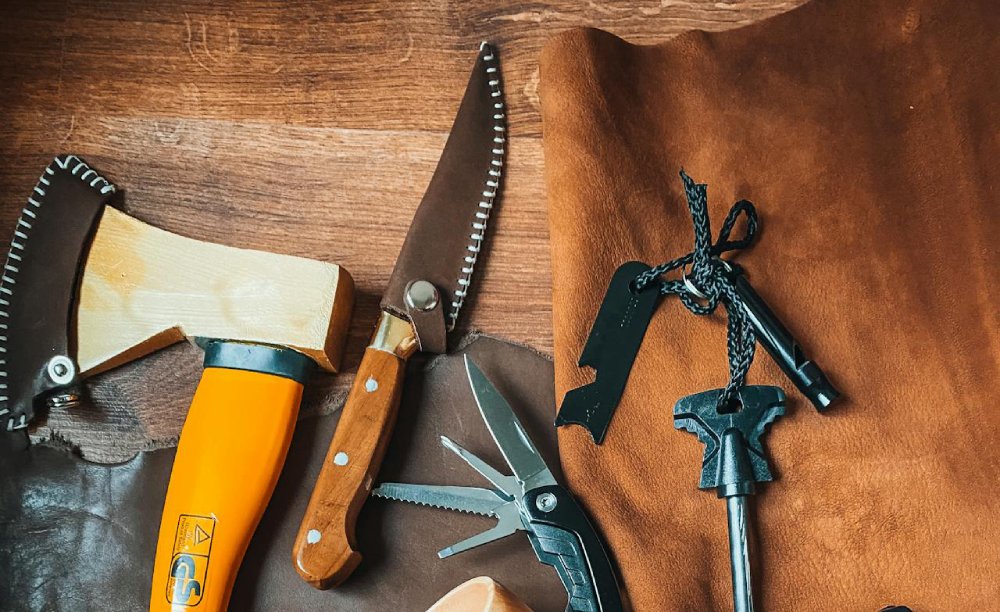When you’re exploring the dark, mysterious world of caves, having the right gear can make all the difference. One of the most essential tools you should carry is a caving knife. It’s not just a regular knife; it’s a lifeline, a tool that could get you out of sticky situations and help you with tasks big and small. But what exactly makes a caving knife so important?
Many cavers are caught off guard when they discover their knife is inadequate for the job. When your knife is weak or dull and you’re stuck trying to cut through fabric or rope in the middle of a dark cave, it can be very frustrating. These issues have the power to transform an exciting journey into a trying circumstance. The answer is straightforward: select the best caving knife for your needs so that you’re prepared for anything that may arise underground.
This post will discuss what constitutes a good caving knife, the various varieties that are out there, and how to pick the ideal one for your travels. By the end, you’ll have all the information you need to decide wisely and protect yourself on your next spelunking adventure.
What Makes a Good Caving Knife?
Selecting a caving knife involves more than just picking the sharpest blade; it also involves choosing a tool that can withstand the particular difficulties that come with caving. A decent caving knife should be strong, manageable, and adaptable. Let’s examine what to look for in more detail:
- Durability: Caving can be tough on your gear, and your knife needs to withstand the elements. Look for knives made from high-quality stainless steel or other corrosion-resistant materials that won’t rust or dull easily.
- Blade Type: The blade of your caving knife should be sharp and reliable. A straight-edged blade is perfect for clean cuts, while a serrated edge can cut through tougher materials like ropes with ease. Some caving knives even offer a combination of both.
- Size and Weight: You don’t want a knife that’s too heavy or bulky, as it could be cumbersome to carry. Opt for a lightweight knife that’s easy to handle, even when you’re in tight spaces or wearing gloves.
- Handle: The handle should provide a secure grip, even when wet or muddy. Rubberized or textured handles are great for ensuring you can maintain control, no matter the conditions.
- Safety Features: Many caving knives come with features like a locking mechanism to keep the blade securely in place when not in use, preventing accidental injuries.
Types of Caving Knives
Caving knives come in different shapes and sizes, each designed with specific purposes in mind. Here are some of the most common types you might consider:
- Folding Knives: These are compact and easy to carry. The blade folds into the handle, making it safe to store in your pocket or attach to your gear. However, they might not be as sturdy as fixed-blade knives.
- Fixed-Blade Knives: Offering superior strength and reliability, fixed-blade knives are ideal for more demanding tasks. They are often the go-to choice for serious cavers who need a knife they can depend on in any situation.
- Rescue Knives: Designed for emergencies, rescue knives often feature a blunt tip to prevent accidental punctures and a serrated edge for cutting through ropes or harnesses quickly. They are essential if you anticipate needing to act fast in a tight spot.
Why You Need a Caving Knife: Real-Life Scenarios
Envision yourself in the depths of a cave when you encounter an unforeseen hindrance. Maybe you need to cut a piece of rope, or maybe you’re tangled in some outdated climbing equipment. A trustworthy caving knife comes in very handy in these kinds of circumstances. Here’s how it can be beneficial:
- Cutting Rope: Whether you’re securing your gear or need to cut a length of rope, a sharp knife can make quick work of it.
- Clearing Debris: Sometimes, you might encounter branches, vines, or other debris blocking your path. A sturdy knife helps you clear these obstacles with ease.
- Emergency Situations: In an emergency, your knife could be the tool that helps you free yourself or a fellow caver from a dangerous situation.
- General Utility: From preparing snacks to fixing gear, a caving knife is a versatile tool that you’ll find yourself using more often than you might think.
Click for the Ultimate Caving Equipment Checklist.
How to Choose the Right Knife
Selecting the perfect caving knife doesn’t have to be complicated. Follow these steps to make sure you pick the right one:
- Assess Your Needs: Think about the type of caving you do most often. Are you exploring wet, muddy caves, or are you in rocky, dry environments? Your knife should suit the specific conditions you’ll face.
- Research: Look at different brands and models of knives. Read reviews from other cavers to see what they recommend and what problems they’ve encountered.
- Consider the Features: Decide if you need a folding knife for easy storage or a fixed-blade knife for strength. Think about the blade type, handle, and any safety features you might want.
- Test the Grip: If possible, handle the knife before you buy it. Make sure it feels comfortable in your hand and that you can grip it securely.
- Check the Durability: Ensure the knife is made from materials that will last. Stainless steel blades and reinforced handles are good choices for longevity.
- Purchase from a Reputable Source: Buy your caving knife from a trusted retailer to ensure you’re getting a quality product.
Caving Knife Care: Keep It in Top Shape
Owning a good caving knife is only half the battle—you also need to take care of it. Here’s how:
- Regular Cleaning: After each trip, clean your knife thoroughly to remove dirt, moisture, and any other debris. This prevents rust and keeps the blade sharp.
- Sharpening: Keep your knife sharp by using a sharpening stone or a professional sharpening service. A dull knife is not only less effective but also more dangerous.
- Proper Storage: Store your knife in a dry place and consider using a sheath or case to protect the blade and handle from damage.
- Routine Inspections: Check your knife regularly for signs of wear and tear. If you notice any damage, consider repairing or replacing the knife to ensure it remains safe to use.

People Also Ask
- What’s the difference between a caving knife and a regular knife?
A caving knife is designed specifically for the challenges of caving, such as cutting rope or dealing with wet conditions. It often includes features like a serrated edge or a blunt safety tip. - Can I use a regular outdoor knife for caving?
While you can, a knife specifically made for caving is better suited for the environment. Regular outdoor knives may not hold up as well in the damp, rough conditions found in caves. - How often should I sharpen my caving knife?
This depends on how often you use it, but a good rule of thumb is to sharpen it after every few trips to keep it in top condition. - Is a folding knife better than a fixed-blade knife for caving?
It depends on your needs. Folding knives are more portable, but fixed-blade knives are typically stronger and more reliable for tough tasks. - What size caving knife should I choose?
A medium-sized knife is usually ideal—large enough to be effective but small enough to handle easily and store in your gear.
Conclusion
A caving knife is more than just a tool; it’s a companion that can make your spelunking adventures safer and more enjoyable. By choosing the right knife, you prepare yourself for the unexpected and ensure you’re ready for any situation that might arise underground. Remember, the best caving knife is one that suits your specific needs, is comfortable to use, and is built to last.
